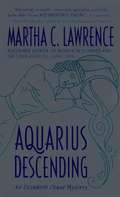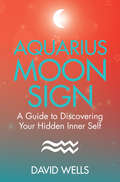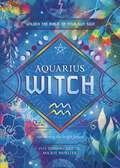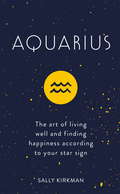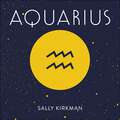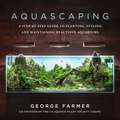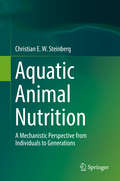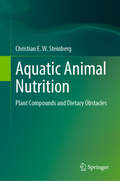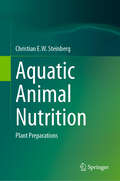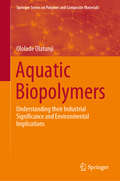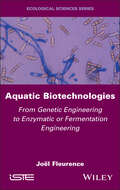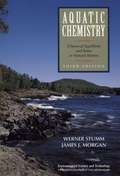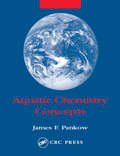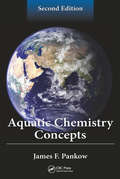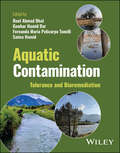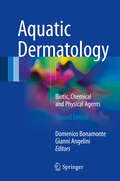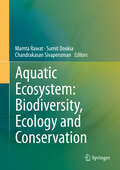- Table View
- List View
Aquarius Descending
by Martha C. LawrenceIn this breakout book of an Edgar-nominated series featuring a paranormal investigator, Elizabeth Chase puts her psychic detecting skills to the ultimate test when she infiltrates the inner circle of a dangerous cult and finds a seductive heart of darkness where the mind is the first to die.
Aquarius Moon Sign: A Guide to Discovering Your Hidden Inner Self
by David WellsWhat if you had a hidden inner self you never knew about? This key to your horoscope is the moon sign!Many people understand their sun sign, but few realise that the key to their astrological insight is unlocked by a deeper truth: the moon sign. Your moon sign is a reflection of your secret inner self, and has important messages to aid you in your career, love life and ultimately your destiny. Understanding the secret power of your moon sign is now easier than ever with this short guide. Specially aligned for your individual moon sign of Aquarius, this book has been carefully charted and prepared by astrology expert David Wells, whose advice will help you quickly understand: • Your overall astrological outlook for 2014• How your moon sign co-operates, or interferes with, your sun sign in 2014• How your moon sign affects your romantic life, your work life and your spiritual life.You won't want to overlook this important part of your astrological make up in the coming year with this brilliant new series! Visit moon-sign-calculator.com to calculate your moon sign and find out yours today!
Aquarius Witch: Unlock the Magic of Your Sun Sign (The Witch's Sun Sign Series)
by Mickie Mueller Ivo DominguezWitchcraft to Celebrate Your Innovative & Independent Self Enhance your magical practice and personal development with the power of your Aquarius Sun sign. Ivo Dominguez, Jr. and Mickie Mueller share what strengths and challenges your sign brings to both witchcraft and everyday life. Featuring recipes, exercises, stories, rituals, and spells from the authors and a host of Aquarius contributors, this book teaches you how to best connect with your sign’s energy, manage your power, cleanse and shield yourself, tailor-fit magical workings to your sign, and more.Contributors to this volume:Silver Daniels • Danielle Dionne • Robin Fennelly • Kieran • Alexandra Nic Bhé Chuille • Sandra Santiago • Dawn Aurora Hunt • Sandra Kynes
Aquarius: The Art of Living Well and Finding Happiness According to Your Star Sign
by Sally KirkmanYou are an Aquarius. You are the innovative thinker and social agent of the zodiac.The signs of the zodiac can give us great insight into our day-to-day living as well as the many talents and qualities we possess. But in an increasingly unpredictable world, how can we make sense of them? And what do they mean? This insightful and introductory guide delves deep into your star sign, revealing unique traits and meanings which you didn't know. Along the way, you will discover how your sign defies your compatibility, how to improve your health and what your gifts are. ***The Pocket Astrology series will teach you how to live well and enhance every aspect of your life. From friendship to compatibility, careers to finance, you will discover new elements to your sign and learn about the ancient art of astrology. Other books in the series include: Aries, Taurus, Gemini, Cancer, Leo, Virgo, Libra, Scorpio, Sagittarius,Capricorn, Aquarius, Pisces
Aquarius: The Art of Living Well and Finding Happiness According to Your Star Sign
by Sally KirkmanYou are an Aquarius. You are the innovative thinker and social agent of the zodiac.The signs of the zodiac can give us great insight into our day-to-day living as well as the many talents and qualities we possess. But in an increasingly unpredictable world, how can we make sense of them? And what do they mean? This insightful and introductory guide delves deep into your star sign, revealing unique traits and meanings which you didn't know. Along the way, you will discover how your sign defies your compatibility, how to improve your health and what your gifts are. ***The Pocket Astrology series will teach you how to live well and enhance every aspect of your life. From friendship to compatibility, careers to finance, you will discover new elements to your sign and learn about the ancient art of astrology. Other books in the series include: Aries, Taurus, Gemini, Cancer, Leo, Virgo, Libra, Scorpio, Sagittarius,Capricorn, Aquarius, Pisces
Aquarius: The Art of Living Well and Finding Happiness According to Your Star Sign
by Sally KirkmanYou are an Aquarius. You are the innovative thinker and social agent of the zodiac.The signs of the zodiac can give us great insight into our day-to-day living as well as the many talents and qualities we possess. But in an increasingly unpredictable world, how can we make sense of them? And what do they mean? This insightful and introductory guide delves deep into your star sign, revealing unique traits and meanings which you didn't know. Along the way, you will discover how your sign defies your compatibility, how to improve your health and what your gifts are. ***The Pocket Astrology series will teach you how to live well and enhance every aspect of your life. From friendship to compatibility, careers to finance, you will discover new elements to your sign and learn about the ancient art of astrology. Other audiobooks in the series include: Aries, Taurus, Gemini, Cancer, Leo, Virgo, Libra, Scorpio, Sagittarius,Capricorn, Aquarius, Pisces(P)2018 Hodder & Stoughton Limited
Aquascaping: A Step-by-Step Guide to Planting, Styling, and Maintaining Beautiful Aquariums
by George FarmerLearn how to create and maintain your own underwater ecosystem. Aquascaping is the art of creating beautiful aquariums with natural materials and live plants. From the brilliance of Takashi Amano and numerous other innovators, aquascapes have become a popular way to enjoy aquariums. In Aquascaping: A Step-by-Step Guide to Planting, Styling, and Maintaining Beautiful Underwater Aquariums, planted aquarium expert George Farmer teaches how to create the perfect aquascape. Included in this book are full-color photographs that will supply readers with: Step-by-step instructions on setting up your tankDifferent styling suggestions that best suit your landscapeHow to pick plants, rocks, driftwood, substrate, and aquatic lifeUnderstanding the chemistry and biology involved in keeping a healthy aquariumMaintenance and upkeepAnd much more Creating an underwater ecosystem is not only a rewarding experience, but can bring much peace and relaxation to your life. So whether you&’re a novice aquarist or seasoned aquascaper, Aquascaping will teach you all the tricks of the trade so that your beautiful aquarium can be enjoyed by family, friends, and, most importantly, yourself.
Aquatic Animal Nutrition: A Mechanistic Perspective from Individuals to Generations
by Christian E. SteinbergThis book is a unique cross fertilization of aquatic ecology and aquaculture. It shows how diets structure the digestive tract and its microbiota and, in turn, the microbiota influences life history traits of its host, including behavior. Short-term starvation can have beneficial effects on individuals themselves and succeeding generations which may acquire multiple stress resistances – a mechanism strengthening the persistence of populations. From terrestrial, but not yet from aquatic animals, it is understood that circadian the rhythmicity makes toxins or good food. On the long-term, the dietary basis impacts succeeding generations and can trigger a sympatric speciation by (epi)-genetics. This volume defines gaps in nutritional research and practice of farmed fishes and invertebrates by referring to knowledge from marine and freshwater biology. It also points out that dietary benefits and deficiencies have effects on several succeeding generations, indicating that well designed diets may have the potential to successfully improve broodstock and breeding effort.
Aquatic Animal Nutrition: Organic Macro- and Micro-Nutrients
by Christian E.W. SteinbergAs sequel to Aquatic Animal Nutrition – A Mechanistic Perspective from Individuals to Generations, the present treatise on organic macro- and micronutrients continues the unique cross fertilization of aquatic ecology/ecophysiology and aquaculture. This treatise considers proteins and their constituents, carbohydrates from mono- to polysaccharides, fatty acids from free acids to fat, and waxes. It becomes obvious that these organic nutrients are more than only simple fuel for the metabolism of animals; rather, their constituents have messenger and controlling function for the actual consuming individual and even for succeeding generations. This aspect will become particularly clear by putting the organisms under consideration back into their ecosystem with their interrelationships and interdependencies. Furthermore, micronutrients, such as vitamins and nucleotides as well as exogenous enzymes, are in the focus of this volume with known and still-to-be-discovered controlling physiological and biomolecular functions.Aquatic Animal Nutrition – Organic Macro and Micro Nutrients addresses several gaps in nutritional research and practice. One major gap is the lack of common research standards and protocols for nutritional studies so that virtually incomparable approaches have to be compared. This applies also to the studied animals, since most approaches disregard intraspecific variabilities and the existence of epimutations in farmed individuals. Furthermore, recalling the Mechanistic Perspective from Individuals to Generations, dietary benefits and deficiencies have effects on succeeding generations. In most studies, this long-term and sustainable aspect is overruled by pure short-term production aspects. By comparing nutritional behavior and success of fishes and invertebrates, Aquatic Animal Nutrition points out different metabolic pathways in these animal groups and discusses how, for instance, fishes would benefit when having some successful metabolic pathway of invertebrates. Application of novel genetic techniques will help turn this vision into reality. However, a widely missing link in the current nutritional research is epigenetics regarding transgenerational heritages of acquired morphological and physiological properties. To increase public acceptance, nutritional optimization of farmed animals based on this mechanism, rather than genetical engineering, appears promising.
Aquatic Animal Nutrition: Plant Compounds and Dietary Obstacles
by Christian E. SteinbergBased on positive experiences in human nutrition and healthy aging, individual and combined plant secondary metabolites are added to aquafeeds. The main compounds used are carotenoids, polyphenols, terpenes, and various alkaloids. The pile of supplementation studies with beneficial results is growing rapidly. These benefits include increased immunity, pathogen resistance, or improved gut microbiome diversity. However, a variety of adverse results cannot be ignored. Overall, in Aquatic Animal Nutrition research, this is another area of that is still in its early stages: as with supplementation of plant preparations (Aquatic Animal Nutrition – Plant Preparations), a robust and guiding hypothesis for supplementation is not apparent, and graded dosing is rarely used, especially in the low-dose range. Often, the high doses used lead to the classification of various compounds as anti-nutritional. However, appropriate low-dose supplementation demonstrates that and how aquatic animals can cope with &‘anti-nutritional&’ factors within their adaptive response, indicating that even these compounds may have some nutritional value. In addition, knowledge of the underlying mechanisms of the adaptive response may provide physiological, transcriptomic, and epigenetic means to more sustainably utilize even this &‘worthless&’ food source. The importance of the intestinal microflora is becoming increasingly clear and points to the imperative need to include gut microbiota in replacement studies. Based on the few epigenetic studies currently available, the importance of these processes is demonstrated. The need to integrate such approaches into future studies is emphasized. The so-called hologenomics approach is inevitable. Supplementing aquafeed with terrestrial plant material can introduce toxins and endocrine disruptors. The addition of adsorptive compounds (clay minerals) or functional feed ingredients (prebiotics, probiotics) can at least partially mitigate the adverse effects.
Aquatic Animal Nutrition: Plant Preparations
by Christian E.W. SteinbergThis volume first covers the supplementation of aquafeeds with terrestrial plant material used in human medicine and nutrition. Mainly based on the “trial and error” approach, many supplements enhance growth, immunity and resistance to stress. However, other supplements appear to be ineffective and some have adverse effects. A robust and guiding hypothesis for supplementation is not apparent. Therefore, the book proposes the use of artificial intelligence to end the trial-and-error phase. In addition, a graded dosing is rarely used, especially in the low-dose range, so the physiological mechanisms behind the supplements are often only partially understood. This topic of aquatic animal nutrition is still in its infancy. Chapters cover medicinal plants in general, selected medicinal plants in detail, food plants, fruits, essential oils, fermentation residues, and genetically modified plants. One chapter attempts to answer the question of what mechanism may underlie ineffective or even harmful supplementation. Overall, the importance of the intestinal microflora is becoming increasingly clear and points to the imperative need to include gut microbiota in replacement studies. Based on the few epigenetic studies currently available, the importance of these processes is demonstrated. The need to integrate such approaches into future studies is emphasized. The so-called hologenomics approach is inevitable. Can adverse effects be mitigated by adding functional feed ingredients such as prebiotics or probiotics? This volume concludes with aquatic plants (macroalgae, filamentous algae, and macrophytes) as food sources for natural and farmed aquatic animals. Can aquaculture learn from natural aquatic herbivores?
Aquatic Biodiversity Conservation and Ecosystem Services (Ecological Research Monographs)
by Shin-Ichi Nakano Tetsukazu Yahara Tohru NakashizukaThis volume examines the topic of local biodiversity conservation in the Asia-Pacific region, one of the most rapidly changing areas in the world. With a focus on aquatic systems, this book offers insight on the state of local biodiversity, challenges in management and conservation of biodiversity, and newly developed methods for monitoring biodiversity. In addition, because the service provided by an ecosystem for humans is interlinked with conservation, the final part is dedicated to evaluating the socioeconomic aspect of ecosystem services, with special reference to local biodiversity. In effect, all contributions provide information that is invaluable for effective conservation and sustainable use of biodiversity. This work will interest all stakeholders in biodiversity conservation, including policy makers, NPOs, NGOs, environment-related industries, and biodiversity researchers, not only in the Asia-Pacific region, but also across the entire globe.
Aquatic Biopolymers: Understanding their Industrial Significance and Environmental Implications (Springer Series on Polymer and Composite Materials)
by Ololade OlatunjiThis book presents a comprehensive survey about the most recent developments in industrial applications, processing techniques and modifications of polymers from marine sources. It systematically introduces the reader to the biomaterials Chitin, Collagen, Alginates, Cellulose and Polyesters and links their interwoven industrial significance and environmental implications. The book elucidates the impact of industrial sourcing of the aquatic system for organic and inorganic matter on the environment and deepens the understanding of the industrial and economic significance of aquatic biopolymers. Further it addresses the question of how to balance the conservation of aquatic life and the industrial and economic interest in developing biodegradable alternatives for plastic. Thus the book will appeal to scientists in the field of chemistry, materials and polymer science as well as engineering.
Aquatic Biotechnologies: From Genetic Engineering to Enzymatic or Fermentation Engineering
by Jöel FleurenceDeveloped over several decades, the concept of aquatic biotechnology refers to aquatic organisms, be they of animal or plant origin. It involves transforming biological resources into products for human and animal consumption. The emergence of transgenic fish (such as AquAdvantage salmon) and their use as foodstuffs has reopened the societal debate on the place of genetically modified organisms in our diet. This new aquaculture based on genetic engineering is known as the "blue revolution." However, "blue" biotechnology is not limited to the production of genetically modified organisms; it also involves the use of biotechnological processes, such as enzymatic hydrolysis and fermentation, on aquatic resources. Aquatic Biotechnologies presents an overview of these biotechnological processes (genetic, enzymatic and fermentative engineering) as applied to aquatic organisms and their production methods (traditional aquaculture and aquaculture producing genetically modified organisms).
Aquatic Chemistry
by James J. Morgan Werner StummThe authoritative introduction to natural water chemistry THIRD EDITIONNow in its updated and expanded Third Edition, Aquatic Chemistry remains the classic resource on the essential concepts of natural water chemistry. Designed for both self-study and classroom use, this book builds a solid foundation in the general principles of natural water chemistry and then proceeds to a thorough treatment of more advanced topics. Key principles are illustrated with a wide range of quantitative models, examples, and problem-solving methods.Major subjects covered include:* Chemical Thermodynamics* Solid-Solution Interface and Kinetics* Trace Metals* Acids and Bases* Kinetics of Redox Processes* Dissolved Carbon Dioxide* Photochemical Processes* Atmosphere-Water Interactions* Kinetics at the Solid-Water* Metal Ions in Aqueous Solution Interface* Precipitation and Dissolution* Particle-Particle Interaction* Oxidation and Reduction* Regulation of the Chemical* Equilibria and Microbial Mediation Composition of Natural Waters
Aquatic Chemistry Concepts
by James F. PankowAquatic Chemistry Concepts fills the need for a true, easy-to-use aquatic chemistry book that goes into the details behind some of the complicated equations and principles of aquatic chemistry. It places established science into a text that allows you to learn and to solve important practical environmental problems. Environmental consultants in all fields, regulators, and libraries will consider this text an excellent reference for its clear explanation of aquatic chemistry principles.
Aquatic Chemistry Concepts, Second Edition
by James PankowAquatic Chemistry Concepts, Second Edition, is a fully revised and updated textbook that fills the need for a comprehensive treatment of aquatic chemistry and covers the many complicated equations and principles of aquatic chemistry. It presents the established science of equilibrium water chemistry using the uniquely recognizable, step-by-step Pankow format, which allows a broad and deep understanding of aquatic chemistry. The text is appropriate for a wide audience, including undergraduate and graduate students, industry professionals, consultants, and regulators. Every professional using water chemistry will want this text within close reach, and students and professionals alike will expect to find at least one copy on their library shelves. Key Features Extremely thorough, one-of-a-kind treatment of aquatic chemistry Discussions of how to carry out complex calculations regarding the chemistry of lakes, rivers, groundwater, and seawater Numerous example problems worked in complete detail Special foreword by Jerry L. Schnoor
Aquatic Contamination: Tolerance and Bioremediation
by Rouf Ahmad Bhat Gowhar Hamid Dar Fernanda Maria Policarpo Tonelli Saima HamidAquatic Contamination Authoritative resource presenting techniques and technologies to sustainably neutralize environmental contamination in aquatic plants, microorganisms, and more Two thirds of the Earth is covered with aquatic habitats that play a key role in stabilizing the global environment and providing a wide variety of services to increasing human needs. Nevertheless, anthropogenic activities are rapidly destroying the quality of both fresh and marine waters globally, due to excessive use of chemicals, fertilizers and pollution from suburban and industrial areas eventually making their way into the aquatic world. Aquatic Contamination: Tolerance and Bioremediation presents the broader spectrum of biological applicability of microbes with better understanding of cellular mechanisms for remediation of aquatic contaminants. The book also focuses on practices involved in molecular and genetic approaches, necessary to achieve targets of bioremediation and phytoremediation to solve global water contamination problems. Such approaches pave the way for the utilization of biological assets to design new, efficient, and environmentally sound remediation strategies by inculcating genomic techniques at cellular and molecular levels with model assessment. Aquatic Contamination provides a comprehensive background for readers interested in all perspectives of the contamination of aquatic environs. It covers various research aspects which are being carried out globally to understand simulation models in the assessment of xenobiotics, role of genomics, transgenic plants, and microbial enzymes for degradation and removal of toxic substances in aquatic environs. Key features include: Extensive coverage of interactions between plants, metals and microbes including the influence of biotic and abiotic factors Comprehensive discussion of the details of molecular mechanisms from assimilation to detoxification levels Exploration of the enzymatic approaches of potential plants acting as hyper-accumulators for contaminants in aquatic environs Details of sustainable tools such as transgenic plants for the manipulation of important functional microbial genes to achieve higher certainty of bioremediation Details of advances in tools and models like micro-arrays and simulation models for the complete assessment of xenobiotic compounds from cellular to degradation hierarchies Aquatic Contamination: Tolerance and Bioremediation will be substantially helpful to environmentalists, microbiologists, biotechnologists and scientists, providing essential information on various modern technologies for the remediation of contaminants in aquatic ecosystems.
Aquatic Dermatology: Biotic, Chemical and Physical Agents
by Domenico Bonamonte Gianni AngeliniThis well-illustrated quick reference book, now in its second edition, is a comprehensive guide to the aquatic skin diseases caused by biotic and non-biotic noxae. It will assist the dermatologist in recognizing and treating a host of unfamiliar conditions that are nevertheless steadily increasing in prevalence owing to wider use of the hydrosphere for holiday, sport, and occupational activities throughout the year. Beyond the thorough examination of the dermatoses caused by a wide range of organisms such as jellyfish, sea anemones, echinoderms, molluscs, algae, aquatic worms, and fish, attention is drawn to potential systemic reactions, which can be serious or even fatal. In addition, the entire spectrum of wound infections and reactions due to microscopic organisms populating the aquatic environment, e. g. , mycobacteria, streptococci, Aeromonas, and vibrios, is considered. Finally, detailed attention is paid to the many other conditions linked to salt or freshwater contact, including aquagenic urticaria and pruritus, chlorine irritation, contact dermatitis from swimming or diving equipment, surfer's nodules, and chemical conjunctivitis. Aquatic Dermatology will be a quick reference to improve knowledge of the aquatic environment and its risks, and a useful tool to clinicians and professionals practicing in coastal and marine areas.
Aquatic Dicotyledons of North America: Ecology, Life History, and Systematics
by Donald H. LesAquatic Dicotyledons of North America: Ecology, Life History, and Systematics brings together a wealth of information on the natural history, ecology, and systematics of North American aquatic plants. Most books on aquatic plants have a taxonomic focus and are intended primarily for identification. Instead, this book provides a comprehensive overview of the biology of major aquatic species by compiling information from numerous sources that lie scattered among the primary literature, herbarium databases, and other reference materials. Included dicotyledon species are those having an obligate (OBL) wetland status, a designation used in the USACE National Wetland Plant List. Recent phylogenetic analyses are incorporated and rationale is provided for interpreting this information with respect to species relationships. This diverse assemblage of information will be useful to a wide range of interests including academic researchers, wildlife managers, students, and virtually anyone interested in the natural history of aquatic and wetland plants. Although focusing specifically on North America, the cosmopolitan distribution of many aquatic plants should make this an attractive text to people working virtually anywhere outside of the region as well. This book is an essential resource for assisting with wetland delineation.
Aquatic Ecosystem: Biodiversity, Ecology And Conservation
by Mamta Rawat Sumit Dookia Chandrakasan SivaperumanThis book brings together the latest information on the rapid advances and developments in the field of aquatic ecology. India is very rich in terms of biological diversity due to its wide range of habitats and climatic conditions. It is home to as much as 7 per cent of the world's animal species, although it only accounts for about 2 per cent of the total landmass. The present work on biodiversity, ecology and conservation of aquatic resources represents original research in the field of aquatic biodiversity, wetland ecology and its applications with reference to the country's aquatic resources. There are 19 chapters, each contributed by an expert in his/her particular field and offering novel approaches to various topics in the area of aquatic ecosystems.
Aquatic Ecosystems
by Nicholas V. C. PoluninConcern about future supplies of fresh water to society, to meet the full range of human needs, now comes very high on the priority list of global societal issues. An overarching issue, which this book addresses, is whether global climate change is a dominant driver of change in the structure and function of all natural water-based ecosystems, or whether direct human population growth and accelerated consumption are playing an equal or greater role. This book divides the whole aquatic realm into 21 ecosystems, from those on land (both saline and fresh water) to those of the open and deep oceans. It draws on the understanding of leading ecologists to summarize the state and likely condition by the year 2025 of each of the ecosystems. Written for academic researchers and environmental professionals, the aim is to put the climate change debate into a broader context as a basis for conservation science and planning.
Aquatic Ecosystems Monitoring: Conventional Assessment to Advanced Remote Sensing
by Prem Chandra Pandey, Prashant K. Srivastava, and Sanjeev Kumar SrivastavaThis book collates traditional and modern applications of remote sensing in aquatic ecosystem monitoring. It covers conventional assessment methods like sampling, surveying, macroinvertebrates, and chlorophyll estimation for aquatic ecosystem health assessment. Advanced remote sensing technology provides timely spectral information for quantitative and qualitative assessment of water quality, shoreline changes, coral bleaching, and vegetation monitoring. The book covers different types of aquatic ecosystems like wetlands, rivers, lakes, saline, and the brackish lake. It also: Reviews the latest applications of remote sensing in the monitoring and assessment of aquatic ecosystems Includes traditional methods like cartography, sampling, surveying, phytoplankton assessment, river interlinking, and chlorophyll estimation Discusses the application of multi-source data and machine learning in monitoring aquatic ecosystems Discusses aquatic ecosystem management, services, threats, and sustainability Explores challenges, opportunities, and prospects of future Earth observation applications for aquatic ecosystem monitoring The book discusses space-borne, airborne, and drone geospatial data. The parts broadly cover aquatic ecosystem monitoring, vegetation management, advanced modeling practices, and challenges. It is meant for scientists, professionals, and policymakers working in environmental sciences, remote sensing, and geology.
Aquatic Ecosystems and Microbial Biofilms: Significance, Dynamics, Prevention and Control
by Ram Prasad Siddhardha BusiAquatic Ecosystems and Microbial Biofilms: Significance, Dynamics, Prevention and Control provides a systematic introduction and review of state-of-the-art information on microbial biofilms in aquatic ecosystems and their control. The book is designed and developed to understand the microbial biofilms in aquatic ecosystems, their role, and the control strategies. The contents of the book are well discussed to get state-of-art knowledge on various topics such as the role of biofilms in marine ecosystems, microbial biofilms, and drinking water systems, biofilms in biofouling and biocorrosion, beneficial aspects of biofilms such as biogeochemical cycling, wastewater treatment, and in biodeterioration of organic materials. This book also provides comprehensive knowledge and in-depth scientific information on the role of biofilms and their contribution to antibiotic resistance, and also advanced technologies to understand biofilms such as metagenomics.The book offers comprehensive coverage of the most essential topics, including: Microbial biofilms in aquatic ecosystems. New horizons to understand the role of biofilms in biofouling and corrosion and their control measures. Beneficial role of aquatic biofilms such as in biogeochemical cycling,wastewater treatment, and biodeterioration of organic materials. Various strategies to collaborate interdisciplinary schemes worldwide to design and develop new methods for cleaner drinking water, and information on advanced techniques such as metagenomics to understand the diversity and functional role of aquatic biofilms. This book serves as a reference book for scientific investigators who would like to study biofilms in aquatic ecosystems, as well as researchers developing methodology in this field to study biofilm formation in aquatic ecosystems, their advantages and disadvantages, and control strategies.
Aquatic Ecosystems in a Changing Climate
by Donat-P Häder Kunshan GaoGlobal climate change affects productivity and species composition of freshwater and marine aquatic ecosystems by raising temperatures, ocean acidification, excessive solar UV and visible radiation. Effects on bacterioplankton and viruses, phytoplankton and macroalgae have farreaching consequences for primary consumers such as zooplankton, invertebrates and vertebrates, as well as on human consumption of fish, crustaceans and mollusks. It has affected the habitation of the Arctic and Antarctic oceans the most so far. Increasing pollution from terrestrial runoff, industrial, municipal and household wastes as well as marine transportation and plastic debris also affect aquatic ecosystems.
